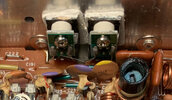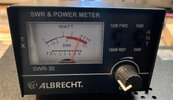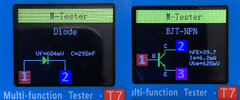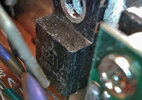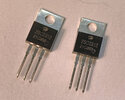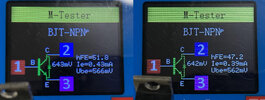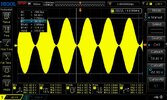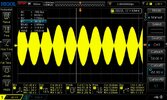Hi everyone!
(Hope this is the right place to post this ;-)
I got hold of a President Grant - Export model, chassis PC-999AD, in very good state.
I completed the whole alignment following the service manual at this link (the schematic is the one at p 26).
All is fine with the radio - with one exception: the RF power is not where it should be.
This kit is rated for 10W AM/FM and 21W for SSB PEP but all I get is 5.3W in AM (unmodulated) and about 9W PEP in SSB.
I started tracing the problem from the finals. This radio uses two final transistors in parallel (TR41 and TR42) to produce double the normal RF power output. Both are identical amplifier circuits driven by the same single driver, TR43.
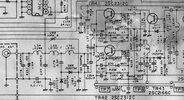
In the alignment, I set the bias of the driver (TR43) at 100mA; for the finals I set the bias at 50mA following advice I saw on some forums (the service manual suggest only 25mA).
I checked the DC bias voltages for the 2 finals and the driver in AM Tx mode unmodulated, and they are all reasonable.
I then measured the signal amplitudes: the driver (TR43) gives 17V p-p on the collector, as it should according to the manual.
The two finals get about 12V p-p amplitude on the base but on the collectors I see only 20V to 22V p-p, whereas it should about 40V p-p according to the manual. Accordingly, in antenna on the dummy load I measure only 47V p-p, corresponding to 5.5W
Here are the signals on the bases of the finals (left) and on the collectors (right) (Tx AM unmodulated).

Here is another picture showing the collector voltage on one of the finals (blue) and on the antenna (yellow).
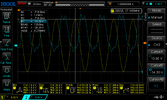
My suspicion is that only one of the finals is working, hence half the power.
Any suggestion on how to verify this without unsoldering the TR41 and TR42 transistors?
Any other suggestions about other possible causes?
Many thanks in advance for your help!
(Hope this is the right place to post this ;-)
I got hold of a President Grant - Export model, chassis PC-999AD, in very good state.
I completed the whole alignment following the service manual at this link (the schematic is the one at p 26).
All is fine with the radio - with one exception: the RF power is not where it should be.
This kit is rated for 10W AM/FM and 21W for SSB PEP but all I get is 5.3W in AM (unmodulated) and about 9W PEP in SSB.
I started tracing the problem from the finals. This radio uses two final transistors in parallel (TR41 and TR42) to produce double the normal RF power output. Both are identical amplifier circuits driven by the same single driver, TR43.

In the alignment, I set the bias of the driver (TR43) at 100mA; for the finals I set the bias at 50mA following advice I saw on some forums (the service manual suggest only 25mA).
I checked the DC bias voltages for the 2 finals and the driver in AM Tx mode unmodulated, and they are all reasonable.
I then measured the signal amplitudes: the driver (TR43) gives 17V p-p on the collector, as it should according to the manual.
The two finals get about 12V p-p amplitude on the base but on the collectors I see only 20V to 22V p-p, whereas it should about 40V p-p according to the manual. Accordingly, in antenna on the dummy load I measure only 47V p-p, corresponding to 5.5W
Here are the signals on the bases of the finals (left) and on the collectors (right) (Tx AM unmodulated).

Here is another picture showing the collector voltage on one of the finals (blue) and on the antenna (yellow).

My suspicion is that only one of the finals is working, hence half the power.
Any suggestion on how to verify this without unsoldering the TR41 and TR42 transistors?
Any other suggestions about other possible causes?
Many thanks in advance for your help!

